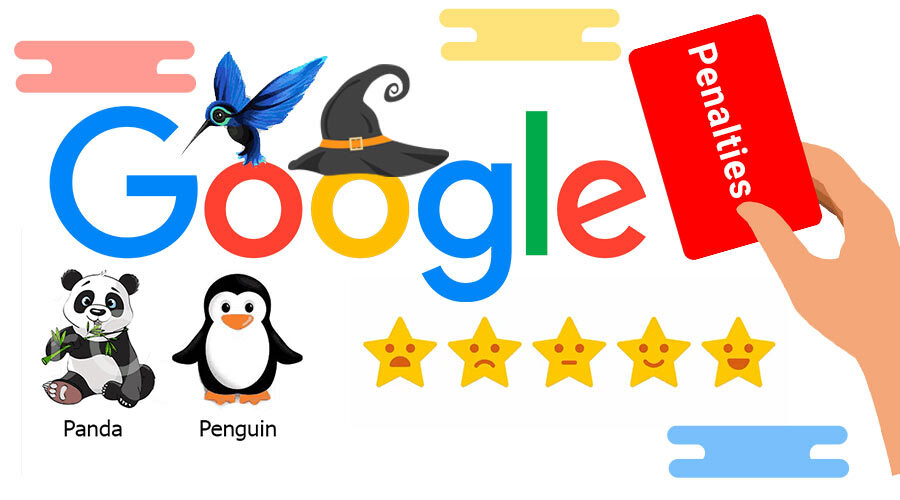What is A Google Penalty?
It implies to the negative measures taken by Google against a site that deviates from its policies and recommended procedures. In its results, the top search engine seeks to offer consumers the highest-quality and most useful material. A site may face penalties that have a detrimental effect on its position in the rankings if it participates in things that are seen as manipulative or in violation of the standards.
These penalties might be in the form of decreased visibility, a decline in search engine positions, or even an entire expulsion from the index. Penalties are frequently imposed for adopting black hat SEO strategies, employing dishonest tactics, having low-quality content, or breaking Google’s Webmaster Standards.
Reasons Why Google Applies Penalties:
Websites are vulnerable to penalties for a variety of factors, all of which are intended to preserve the reliability and fineness of search engine outcomes. Typical causes include the following:
- Involvement in the development of artificial or fraudulent backlinks, such as link purchasing, link-building schemes, or the use of automated link-building programmes, etc.
- Overusing keywords in a piece of writing.
- Displaying material to search engines that differs from what is seen to people.
- A Google Penalty may be imposed on a site that contains a huge volume of copied material.
- Sites with low-quality or weak material that lacks comprehensiveness and significance.
- Sites that carry out damaging operations, such phishing, malware distribution, or other illicit activity.
- Penalties may be imposed on sites with inadequate navigation, sluggish loading speeds, or other usability problems.
- Penalties apply for violations of Google’s Webmaster recommendations, such as deceptive redirection and concealed material.
How Google Notifies About Penalties?
Penalties are usually sent to website owners by Google via its Search Console tool. These are typical methods:
Manually Taken Actions in Search Console:
Webmasters can obtain information regarding any manually administered penalties imposed on their site through the Manual Actions report available in Google’s Search Console platform. It contains details on the problem, including the particular offence and the web-pages that are impacted.
Sending Email Notifications:
The email address linked to the Search Console platform receives email alerts. These communications frequently include details regarding the fine, the rationale behind it, and remedial measures that may be taken.
Sending Messages in Search Console:
Webmasters are able to receive alerts about problems or penalties straight from the Search Console dashboard. These alerts include information on issues that have been identified as well as suggestions for fixing them.
Notifying about Security Issues:
Google may notify users by means of email and the Search Console if it finds security problems on a site, including malware or phishing efforts.
Actions Required to be Taken After Penalty is Applied:
In order to overcome the problems and rebuild your site, it’s critical that you move quickly and strategically if it has been penalised. These are measures that you can take:
Identifying the Penalty:
To understand more about the particular problems that decided the penalty, view the Google Search Console Manual Actions report. Details on the penalty category and impacted pages are included in it.
Understanding the Underlying Issue:
Examine the rules and regulations in detail to determine the specifics of the breach. This knowledge is essential for carrying out remedial actions that work.
Addressing the Root Cause:
Handle the problems that caused the fine. This might entail eliminating artificial or spammy links, correcting the overabundance of keywords, bettering the quality of the material, or taking care of any other rules breaches.
Cleaning Up Your Backlink Profile:
Perform a comprehensive backlink assessment and eliminate any spammy or poor-quality backlinks if the penalty is connected to unnatural connections. To raise the link profile of your site, put your efforts into creating natural, links that are of excellent quality.
Improving Content Quality:
Make the material better on your site in terms of quality and relevancy. Make sure it satisfies the requirements for high-quality content and offers users something of value.
Checking for Prevailing Security Issues:
In the event that the penalty stems from security breaches, including malware or phishing, take prompt action to resolve the concerns. Make sure that your internet presence is safe, and do frequent security vulnerability scans.
Submitting a Reconsideration Request:
After handling the issues at hand, use Google Search Console for submitting a re-evaluation request. Clearly outline the actions you have done to address the things and stop such infractions in the future.
Remain Patient:
Revision by Google is a lengthy procedure. Have patience and keep an eye out for changes in your Search Console. If the concerns have been satisfactorily remedied, it can take a few weeks for the appeal to be reviewed and the penalty lifted.
Implementing the Best Practices:
Follow Google’s Webmaster Directions and SEO recommended practises moving forward. Keep yourself updated about algorithm changes, and adapt your approach as necessary.
Monitoring the Performance:
Keep an eye on the traffic, user interaction, and search engine rankings of your internet presence on a regular basis. Maintain an eye out for any updates or problems with the Search Console.
Conclusion:
Recovery from a Google penalty necessitates a dedication to moral SEO tactics and continuous website upkeep. You may increase the likelihood of recovering from a penalty and restoring exposure in search results by taking care of the underlying issues and keeping your site tidy and easy to use.







